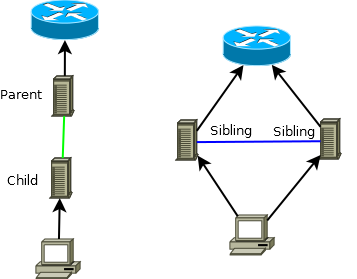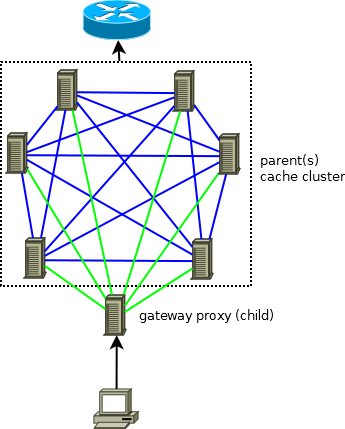🔗 Feature: Linking Squid into a Cache Hierarchy
- Goal: To connect multiple Squid together forming a ‘mesh’ or hierarchy of caches.
- Status: completed.
- Version: 1.2
🔗 Details
Proxy and Cache Hierarchies are built out of two basic peering linkages. parent links (shown as green) and sibling links (show as blue).

These two simple connections can be combined in any number of complex hierarchies. For example this cluster of 6 sibling caches with a gateway proxy load balancing between them.

🔗 How do I configure Squid forward all requests to another proxy?
First, you need to give Squid a parent cache with the cache_peer directive. Second, you need to tell Squid it can not connect directly to origin servers with never_direct. This is done with these configuration file lines:
cache_peer parentcache.foo.com parent 3128 0 no-query default
never_direct allow all
Note, with this configuration, if the parent cache fails or becomes unreachable, then every request will result in an error message.
In case you want to be able to use direct connections when all the parents go down you should use a different approach:
cache_peer parentcache.foo.com parent 3128 0 no-query
prefer_direct off
nonhierarchical_direct off
The default behavior of Squid in the absence of positive ICP, HTCP, etc replies is to connect to the origin server instead of using parents. The prefer_direct off directive tells Squid to try parents first before DNS listed servers.
Certain types of requests cannot be cached or are served faster going direct, and Squid is optimized to send them over direct connections by default. The nonhierarchical_direct off directive tells Squid to send these requests via the parent anyway.
The hierarchy_stoplist directive is another which will cause traffic to go DIRECT instead of to a peer. It should be removed completely from Squid-3.2 and later configurations if present.
🔗 How do I join a cache hierarchy?
To place your cache in a hierarchy, use the cache_peer directive in squid.conf to specify the parent and sibling nodes.
For example, the following squid.conf file on childcache.example.com configures its cache to retrieve data from one parent cache and two sibling caches:
# squid.conf - On the host: childcache.example.com
#
# Format is: hostname type http_port udp_port
#
cache_peer parentcache.example.com parent 3128 3130
cache_peer childcache2.example.com sibling 3128 3130
cache_peer childcache3.example.com sibling 3128 3130
cache_peer_domain is deprecated and not longer available from current Squid versions.
The cache_peer_access directive allows you to specify that certain caches siblings or parents for certain domains:
# squid.conf - On the host: sv.cache.nlanr.net
#
# Format is: hostname type http_port udp_port
#
cache_peer electraglide.geog.unsw.edu.au parent 3128 3130
cache_peer cache1.nzgate.net.nz parent 3128 3130
cache_peer pb.cache.nlanr.net parent 3128 3130
cache_peer it.cache.nlanr.net parent 3128 3130
cache_peer sd.cache.nlanr.net parent 3128 3130
cache_peer uc.cache.nlanr.net sibling 3128 3130
cache_peer bo.cache.nlanr.net sibling 3128 3130
acl unsw dstdomain .au
cache_peer_access electraglide.geog.unsw.edu.au allow unsw
acl nzgate dstdomain .au .aq .fj .nz
cache_peer_domain cache1.nzgate.net.nz allow nzgate
acl nlanr-eu dstdomain .uk .de .fr .no .se .it
cache_peer_domain pb.cache.nlanr.net allow nlanr-eu
cache_peer_domain it.cache.nlanr.net allow nlanr-uk
acl nlanr-sa dstdomain .mx .za .mu .zm
cache_peer_domain sd.cache.nlanr.net allow nlanr-sa
The configuration above indicates that the cache will use pb.cache.nlanr.net and it.cache.nlanr.net for domains uk, de, fr, no, se and it, sd.cache.nlanr.net for domains mx, za, mu and zm, and cache1.nzgate.net.nz for domains au, aq, fj, and nz.
🔗 How do I join NLANR’s cache hierarchy?
Currently (December 2022) unclear
🔗 Why should I want to join NLANR’s cache hierarchy?
The NLANR hierarchy can provide you with an initial source for parent or sibling caches. Joining the NLANR global cache system will frequently improve the performance of your caching service.
🔗 How do I register my cache with NLANR’s registration service?
Just enable these options in your squid.conf and you’ll be registered:
cache_announce 24
announce_to sd.cache.nlanr.net:3131
Announcing your cache is not the same thing as joining the NLANR cache hierarchy. You can join the NLANR cache hierarchy without registering, and you can register without joining the NLANR cache hierarchy
🔗 How do I find other caches close to me and arrange parent/child/sibling relationships with them?
Visit the NLANR cache registration database to discover other caches near you. Keep in mind that just because a cache is registered in the database does not mean they are willing to be your parent/sibling/child. But it can’t hurt to ask…
🔗 Troubleshooting
🔗 My cache registration is not appearing in the Tracker database.
- Your site will not be listed if your cache IP address does not have a DNS PTR record. If we can’t map the IP address back to a domain name, it will be listed as “Unknown.”
- The registration messages are sent with UDP. We may not be receiving your announcement message due to firewalls which block UDP, or dropped packets due to congestion.
Categories: Feature
Navigation: Site Search, Site Pages, Categories, 🔼 go up